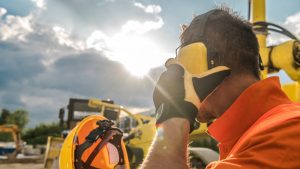Canada’s building industry has been thrown a lifeline, with provinces allowing most construction work to continue during the COVID-19 emergency period. At the same time, however, Ontario Premier Doug Ford has thrown down the gauntlet in terms of site conditions.
“Let me be very clear to all construction workers,” Ford said. “If you don’t feel safe in your workplace, your job will be protected, you can leave the job site. I’ll have zero tolerance for sites that have overflowing outhouses, don’t have hand sanitizer [or] running water.” Ford said the province would ramp up inspections and wouldn’t hesitate to shut down sites that aren’t complying.
“If a worker considers a worksite to be unsafe, or a work task to be unsafe, they have the ability to engage in work refusal,” says Keith Burkhardt of employment and labour law specialist Sherrard Kuzz LLP. However, under current legislation, workers cannot in fact simply walk off the site as the Premier suggests.
“Unfortunately, we’ve seen situation where workers have just simply left the site saying, ‘I don’t consider it sanitary,’ or ‘I’m worried about COVID-19, I’m leaving.’ That is not a proper work refusal and cannot be condoned or permitted. Fortunately, we’ve seen several unions walk that back and say, ‘No, no, no. Let’s go through the appropriate process.”
That process, says Burkhardt, requires the worker to report their work refusal to a safety representative, supervisor or employer. An investigation is then launched. Hopefully the issue can be resolved on site through improved measures or reassignment to another task. Failing that, the employer must contact the Ministry of Labour resulting in a Ministry investigation involving the worker and company representatives, followed by a report. Site changes may be required, or the worker instructed to return to work.
However, matters need not get to that point if the contractor has already taken appropriate steps to ensure proper worksite health and safety. Now more than ever, this means maintaining not only good sanitary conditions but also formulating and documenting a COVID-19 prevention, mitigation and response plan.
On Sunday, Ontario Minister of Labour, Training and Skills Development Monte McNaughton, spelled out contractors’ specific responsibilities: providing better on-site sanitation, including a focus on high-touch areas like site trailers, door handles and hoists; communicating roles, responsibilities, and health & safety policies by, for example, posting site sanitization schedules and work schedules; enabling greater distances between workers by staggering shifts, restricting site numbers and limiting elevator usage; and protecting public health by tracking and monitoring workers.
Specific to COVID-19, it’s important that contractors maintain clear communication with workers concerning proactive actions regarding COVID-19 prevention and appropriate response measures. “On a work site, I ought to have the trust that the person I’m working beside has thought about the risks, and that my employer has thought about this and has taken steps to try to minimize the risk of transmission,” says Burkhardt. This communication needs to be extended to suppliers, affiliates and employees — essentially anyone with access to the site and the work force.
Burkhardt suggests questioning all site visitors concerning their activities within the last 14 days. Have they travelled outside Canada or been on a cruise ship? Do they demonstrate any of the known early symptoms like coughing or fever? Have they been diagnosed or been in close contact with someone who has? If so, access must be denied.
Further measures include taking the temperatures of everyone entering the site, using a non-oral, infrared device. If their measured temperature exceeds 100 degrees, take a second reading and deny access if the reading is the same.
Contractors could also consider downsizing the size of work teams, staggering lunch and break times, assess alternative means or locations for work or production, or going with skeleton crews.
Above all, Burkhardt says that the successful continuance of construction during the COVID-19 emergency depends on contractors maintaining a gold standard of health and safety. “Look for opportunities to be a level above, to be that much better than everyone else.”
John Bleasby is a Coldwater, Ont. based freelance writer. Send comments and Legal Notes column ideas to editor@dailycommercialnews.com.











Recent Comments